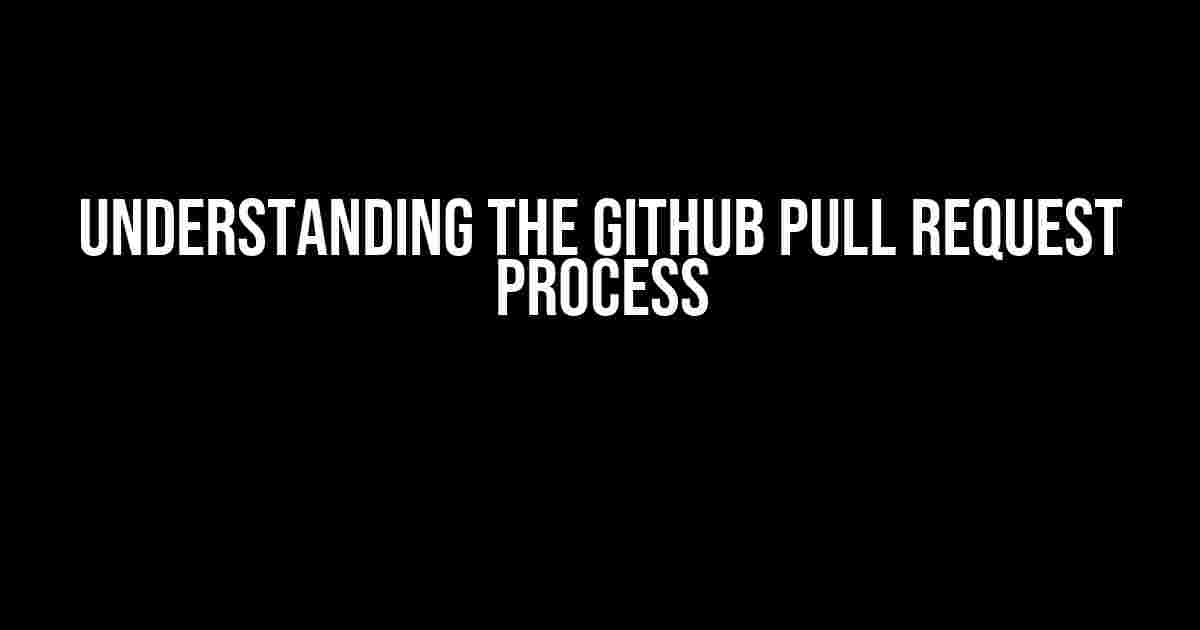Have you ever faced a situation where your pull request task is marked as successful, but surprisingly, nothing gets pushed to the repository? You’re not alone! This frustrating issue can occur due to various reasons, leaving you wondering what went wrong. Fear not, dear developer, for we’re about to embark on a troubleshooting adventure to identify and fix the problem.
Understanding the GitHub Pull Request Process
Before we dive into the troubleshooting process, let’s take a step back and understand how GitHub’s pull request process works. When you create a pull request, GitHub performs a series of checks to ensure your code is valid and ready for merging.
- GitHub creates a temporary branch for the pull request, known as the “pull request ref.”
- The pull request ref is built and tested using your repository’s CI/CD pipeline.
- If the build and tests are successful, the pull request is marked as “success.”
- After approval, the pull request is merged into the target branch.
Common Reasons for Pull Request Task Success without Pushing Changes
Now that we’ve covered the basics, let’s explore some common reasons why your pull request task might be successful, but nothing gets pushed:
Reason 1: Misconfigured CI/CD Pipeline
One of the most common culprits is a misconfigured CI/CD pipeline. If your pipeline is not configured to push changes to the repository, the pull request task will be marked as successful, but no changes will be pushed.
jobs:
build-and-deploy:
runs-on: ubuntu-latest
steps:
- name: Checkout code
uses: actions/checkout@v2
- name: Run build and tests
run: |
./build-and-test.sh
- name: Push changes
uses: actions/checkout@v2
run: |
git push origin main
In the above example, the CI/CD pipeline is not configured to push changes to the repository. To fix this, add a step to push changes to the repository using git push origin main or equivalent command.
Reason 2: Branch Protection Rules
Branch protection rules can also prevent changes from being pushed to the repository. If your repository has branch protection rules enabled, it may reject the push request.
| Branch Protection Rule | Description |
|---|---|
| Require pull request reviews | Requires at least one approved review before changes can be merged. |
| Require status checks to pass before merging | Checks if the CI/CD pipeline has passed before allowing the merge. |
| Require signed commits | Requires all commits to be signed with a GPG key or SSH certificate. |
To resolve this, review your branch protection rules and adjust them accordingly. You can do this by going to your repository’s settings, navigating to the “Branches” tab, and editing the branch protection rules.
Reason 3: Repository Permissions
Sometimes, repository permissions can restrict access to pushing changes. If the user or bot performing the push doesn’t have the necessary permissions, the push request will be rejected.
To fix this, ensure the user or bot has the necessary permissions to push changes to the repository. You can do this by going to your repository’s settings, navigating to the “Collaborators & teams” tab, and adding the necessary permissions.
Reason 4: Network Connectivity Issues
Network connectivity issues can cause the push request to fail. If your CI/CD pipeline is running on a remote server or GitHub Actions, network issues can prevent the push from completing successfully.
To troubleshoot this, check your network connectivity and ensure that the CI/CD pipeline can connect to the GitHub repository. You can also try retrying the push request or adjusting the pipeline’s timeout settings.
Troubleshooting Steps
Now that we’ve covered the common reasons, let’s go through some troubleshooting steps to identify and fix the issue:
- Check the CI/CD pipeline configuration: Review your pipeline configuration to ensure it’s correctly pushing changes to the repository.
- Verify branch protection rules: Check your branch protection rules to ensure they’re not preventing the push request.
- Check repository permissions: Ensure the user or bot performing the push has the necessary permissions.
- Check network connectivity: Verify that the CI/CD pipeline can connect to the GitHub repository.
- Check the GitHub status page: Visit the GitHub status page to see if there are any known issues or outages affecting your repository.
- Check the CI/CD pipeline logs: Review the pipeline logs to identify any errors or issues that may be preventing the push.
Conclusion
In conclusion, a pull request task being successful but nothing getting pushed can be a frustrating issue, but by understanding the GitHub pull request process, identifying common reasons, and following the troubleshooting steps, you can resolve the issue and get your changes pushed to the repository.
Remember to always review your CI/CD pipeline configuration, branch protection rules, repository permissions, and network connectivity. By being proactive and methodical in your troubleshooting approach, you’ll be able to identify and fix the issue, ensuring your pull request is successful, and your changes are pushed to the repository.
Frequently Asked Question
Feeling stuck when your pull request task is successful, but nothing gets pushed? Relax, we’ve got you covered! Here are some FAQs to help you troubleshoot the issue:
Why does my pull request task show as successful, but no changes are reflected in the repository?
This might happen if the pull request is still pending review or has been closed without merging the changes. Double-check the pull request status and ensure it’s been merged successfully. Also, verify that the correct branch is being pushed to and that the push permissions are in place.
Is it possible that the changes are being pushed to a different branch?
Yes, it’s possible! Make sure you’re pushing to the correct branch, and that the branch is correctly set up in your Git configuration. You can check the Git configuration by running the command `git config -l` and verifying the remote URL and branch settings.
What if I’ve made changes to the repository settings or access permissions?
A recent change to the repository settings or access permissions might be causing the issue. Review the repository settings, access permissions, and collaborator settings to ensure they’re correctly configured. If you’ve recently added or removed collaborators, ensure they have the necessary permissions to push changes.
Can a Git hook be blocking the push?
Yes, it’s possible that a Git hook is blocking the push. Check the Git hook scripts in your repository to ensure they’re not preventing the push. You can try bypassing the hooks using the `–no-verify` flag with the push command, such as `git push –no-verify origin
What if none of the above solutions work?
If none of the above solutions work, try pushing the changes manually using the Git command line. If the push still fails, try checking the Git logs for any errors or warnings. If you’re still stuck, reach out to your repository administrator or a Git expert for further assistance.



